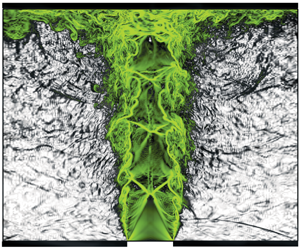Article contents
Receptivity characteristics of under-expanded supersonic impinging jets
Published online by Cambridge University Press: 26 February 2020
Abstract

The receptivity of an under-expanded supersonic impinging jet flow at a sharp nozzle lip to acoustic impulse disturbances is investigated as a function of geometric and flow parameters. The under-expanded supersonic jets emanate from an infinite-lipped nozzle, i.e. the nozzle exit is a circular hole in a flat plate. Two specific cases have been investigated corresponding to nozzle-to-wall distances of  $h=2d$ and
$h=2d$ and  $5d$, where
$5d$, where  $d$ is the jet diameter, at a nozzle pressure ratio of 3.4 and a Reynolds number of 50 000. Receptivity in this study is defined as originally coined by Morkovin (Tech. Rep. AFFDL TR, 1969, pp. 68–149; see also Reshotko, AGARD Special Course on Stability and Transition of Laminar Flow, N84-33757 23-34) as the internalisation of an external disturbance into the initial condition that either initiates or sustains a vortical fluid dynamic instability. Notionally, receptivity can be considered as a transfer function between the external disturbance and the initial conditions of the vortical instability. In the case of under-expanded supersonic impinging jet flow subjected to an acoustic disturbance, this transfer function is located at the nozzle lip and, thus, is amenable to an impulse response analysis using the linearised compressible three-dimensional Navier–Stokes equations. In this study, the transfer function at the nozzle lip is defined as the ratio of the output flow energy to the input acoustic energy of the acoustic disturbance. The sensitivity of this transfer function to the angular acoustic disturbance location, its azimuthal mode number and Strouhal number has been investigated for the two under-expanded supersonic impinging jet flow cases. It is found that for both the
$d$ is the jet diameter, at a nozzle pressure ratio of 3.4 and a Reynolds number of 50 000. Receptivity in this study is defined as originally coined by Morkovin (Tech. Rep. AFFDL TR, 1969, pp. 68–149; see also Reshotko, AGARD Special Course on Stability and Transition of Laminar Flow, N84-33757 23-34) as the internalisation of an external disturbance into the initial condition that either initiates or sustains a vortical fluid dynamic instability. Notionally, receptivity can be considered as a transfer function between the external disturbance and the initial conditions of the vortical instability. In the case of under-expanded supersonic impinging jet flow subjected to an acoustic disturbance, this transfer function is located at the nozzle lip and, thus, is amenable to an impulse response analysis using the linearised compressible three-dimensional Navier–Stokes equations. In this study, the transfer function at the nozzle lip is defined as the ratio of the output flow energy to the input acoustic energy of the acoustic disturbance. The sensitivity of this transfer function to the angular acoustic disturbance location, its azimuthal mode number and Strouhal number has been investigated for the two under-expanded supersonic impinging jet flow cases. It is found that for both the  $h=2d$ and
$h=2d$ and  $5d$ cases, acoustic disturbances located at angles greater than
$5d$ cases, acoustic disturbances located at angles greater than  $80^{\circ }$ from the jet centreline, with Strouhal numbers in the range between 0.7 and 6.5, have the highest receptivity for all azimuthal mode numbers investigated, except the azimuthal mode number 2 in the case of
$80^{\circ }$ from the jet centreline, with Strouhal numbers in the range between 0.7 and 6.5, have the highest receptivity for all azimuthal mode numbers investigated, except the azimuthal mode number 2 in the case of  $h=5d$. The case with
$h=5d$. The case with  $h=5d$ is found to also have high receptivity to acoustic disturbances located at angles between
$h=5d$ is found to also have high receptivity to acoustic disturbances located at angles between  $15^{\circ }$ and
$15^{\circ }$ and  $50^{\circ }$ from the jet centreline for acoustic disturbances of all azimuthal mode numbers.
$50^{\circ }$ from the jet centreline for acoustic disturbances of all azimuthal mode numbers.
- Type
- JFM Papers
- Information
- Copyright
- © The Author(s), 2020. Published by Cambridge University Press
References
- 19
- Cited by




